How to Stop a Washing Machine From Moving Around
Author: Omar Alonso | Editor: Omar Alonso
Review & Research: Jen Worst & Chris Miller
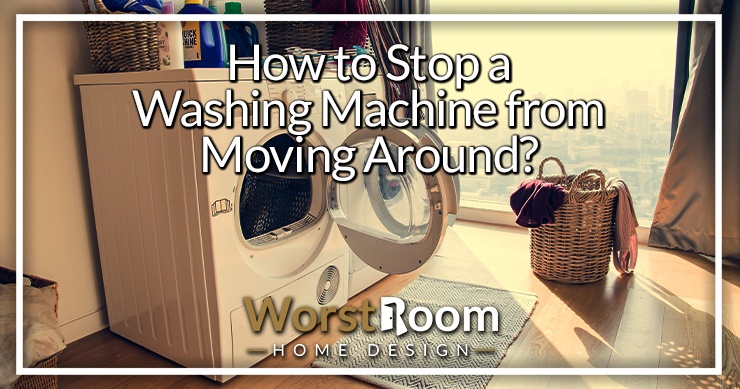
Is your washing machine moving across the laundry room when the spin cycle hits? This movement (or "walking") occurs in various intensities and for several reasons. From a slight bumping and jerking to a wild rodeo-style bucking motion, if your washing machines are moving around, something is causing the problem.
Washing machines aren't meant to move when they operate. Sure, they might make noise, but if they're bucking across the laundry room, requiring you to sit on it, there's something wrong, and you need to look into it.
This post unpacks the reasons why your washing machine isn't behaving itself. We'll examine common problems and how to stop a washing machine from moving when spinning.
Why Does My Washing Machine Walk Around & Shake?
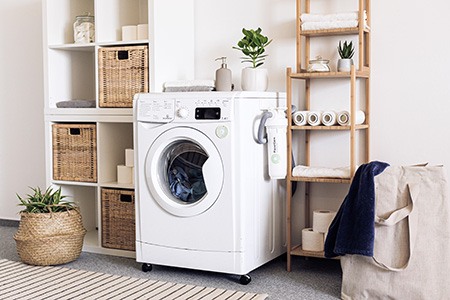
Your washing machine operates by turning the drum to spin the clothing and push the water and laundry detergent into the fabrics. The washing phase involves gentle tumbling, but the spin cycle increases the drum speed, forcing the water out of the drum to remove as much moisture from the clothes as possible.
Without the spin cycle, you would pull sodden clothing from the machine. Modern washing machines have an intelligent design to counter the centrifugal force involved with the spin cycle. Components like suspension rods and shock absorbers contain the movement within the drum, keeping the machine still.
If the washer isn't set up right or its shock-absorbing components are worn, the centrifugal forces in the drum cause the machine to act wild. You can see the difference centrifugal force makes on your body. If you're reading this in an office swivel chair, push away from the desk for a second.
Touch your legs under the seat and spin yourself around in the chair. When you get going, extend your legs out and watch what happens. You'll notice a wild change in the speed of the turn, and you'll find the chair moves slightly as you extend your legs.
The same happens when the washer loses control of the centrifugal forces generated by the spin cycle. Before you know it, it's moved far enough to unhook or damage your washing machine drainage tubes or pipes, left scuff marks on your floor, or even knocked into the closet door.
Does a Moving Washing Machine Cause Damage to Itself?
If your washing machine is moving around during the spin cycle, it's not the normal function of the washer and needs fixing. It's annoying for users because many people will even spend time sitting on the machine during the spin cycle to prevent it from walking around.
Sometimes, even sitting on the washer isn't enough to prevent movement. The movement also drops the machine's efficiency and causes faster wear and tear of the internal components. If it's moving, you'll need to do something about it soon.
How to Keep a Washer From Moving When Spinning

You can do a few things to stop the washing machine from moving around, such as making sure the washer and dryer dimensions aren't too small or large for the place you're positioning them. You'll need to ensure you have the washer set up correctly and that you're using it properly.
If you buy a new washing machine, it is essential to ensure proper setup before you start using it. Let's look at preventative measures you can take for the appropriate setup of your washer.
Place the Washer on a Level Surface
Before operating, you'll need to place the washer on a flat, stable surface. Just a slight incline or decline of the floor can create an imbalance, causing alterations to the centrifugal force and throwing it off balance during the spin cycle.
Use a spirit level and check that the flooring is level. Many smartphone apps offer a spirit-level function if you don't have the tool handy.
Don't Wash an Unbalanced Load
You'll need to ensure you have a balanced load in the drum when operating the washer. Overloading the drum is an easy way to throw everything off-balance, which is often the case when a washing machine moves. This rule applies to front-loading washers, but it's important to never overload any washer, regardless of design.
Overloading places stress on the machine, reducing its service life. Overloading a front-loading washer causes excessive swinging in the drum, leading to the washer shaking. Spread the laundry evenly inside the drum, and don't overload the machine.
Remember to Remove Shipping Bolts
This is one of the biggest mistakes people make when purchasing a new washer. It's also the most common reason for causing the washer to walk around and buck wildly during the spin cycle. When manufacturers pack the washer at the factory, they bolt a packing weight to the drum so it doesn't spin during shipping.
When you receive the washer, you'll have to open the back of the machine and use tools to remove the packing weight. Most manufacturing brands attach the weight to the drum using butterfly nuts that are easy to loosen with your fingers.
If you don't remove the packing weight, it causes an imbalance of the centrifugal forces on the drum during the spin cycle, resulting in severe movement and shaking of the washer.
Adjust the Washing Machine’s Feet
Most washing machines come with rubber feet on the base. The feet prevent metal contact that might scratch the flooring. Some models have screw-in feet allowing you to adjust the height in each corner. If the feet are out of position, it's like installing the washer on an incline of decline.
This problem affects the centrifugal force of the drum. If you buy a used machine with missing or worn feet, it affects the correct operation of the washer, and you'll need to replace them. We also have a suggestion below that's probably the best solution to this problem when combined with leveling the feet.
Reasons Why the Washing Machine Is Moving Around
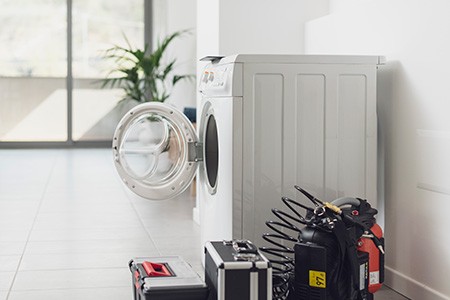
There are several reasons why the washer might be bucking and moving around the laundry room. Here are the most common reason causing the problem.
If you don’t have any experience repairing stuff around the house, it’s a good idea to send it to a service center for repair instead of trying to fix it yourself.
Damaged Suspension Rods
Top-loading washers have suspension rods that perform a shock-absorbing function. The rods dampen drum movement and prevent shaking.
Cause of Failure
The suspension rods can break due to normal wear and tear on the washer. If one fails, the drum won't have complete suspension and alignment, resulting in an imbalance that throws off the drum during the spin cycle.
How to Repair It
Remove the machine's top or back service panel to gain access to the drum. Use a visual inspection to see which rods are broken and need replacing. It's common for one or two to fail, but the chances of them all being damaged are slim.
Contact a service center and buy a spare replacement rod and fit it to the washer, it's a simple DIY task, and you probably won't have to hire someone to do the job.
Worn Rubber Feet
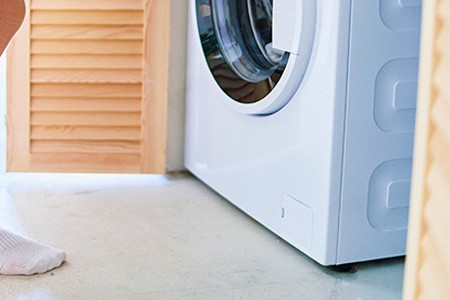
As mentioned, the washer rubber feet balance the machine, ensuring effective operation and reduce normal amounts of a washing machine moving around. The feet are on all four corners of the washer.
Some models may allow for hand tightening or loosening, while others might require a wrench to make the adjustment. Some manufacturing brands include a specialized flat wrench for the task. Your goal is to adjust the height of the feet so that the washing machine rests level on the floor, even if the floor is unlevel.
Cause of Failure
The rubber feet will eventually wear away. Depending on your climate, it might take a few years before you have to worry about this issue with a new machine. However, if you're buying second-hand, it pays to check the condition of the feet before setting it up.
How to Repair It
Most manufacturing brands sell rubber feet in sets of four. They're rarely sold as singles. The manufacturer will also include the wrench, if required, to remove the old feet and install the new ones. Fit the feet and use the wrench to adjust them all to the correct height.
Worn or Damaged Shock Absorbers
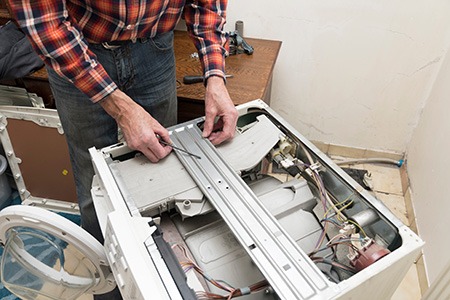
Front-loading washers have shock absorbers in the base of the machine to absorb additional movement from the drum when it's speeding up and slowing down during the spin system. They're like suspension rods in top-loading washers.
Cause of Failure
The shock absorbers are another part of the washer prone to normal wear and tear from its regular operation. Given enough time, they'll eventually fail on any machine and require replacement. The normal operating dynamic of the washer place stresses on these components, causing them to fail.
How to Repair It
You'll have to send the machine to the service center for repair if you have this problem. The service agent removes the panel at the bottom of the washer to access the shock absorbers, and you might not have the skills required to complete this task.
If you're dealing with any of the above problems, you can explore washing machine alternatives for in the meantime or you can drive your laundry down the a laundry mat to wash them. Some laundry mats will allow you to drop off your laundry and they'll clean and fold it for you for an extra fee.
Use Anti-Vibration Feet to Stop Your Washing Machine Moving
Several accessories are available to secure your washer and prevent it from moving. Buy a non-slip mat, it prevents it from slipping around and bouncing around on tiled floors. You also have options for anti-slip, anti-vibration pads you fit on the feet to enhance shock absorption and resist movement. You can place these under your pedestals or pedestal alternatives as well.
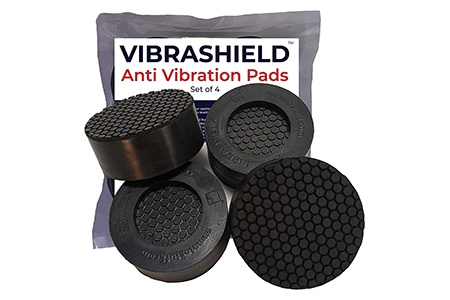
Most accessories are affordable and readily available from manufacturing brands, hardware stores, and online retailers. While they're nice, they are necessary as long as you set the machine upright following the tips in this post. You'll find the problem and correct it with the right maintenance and preventative measures.
That's How to Stop a Washing Machine From Walking
Assuming you don't have any deeper issues related to any of the parts of the washing machine malfunctioning, you're typically just dealing with an un-level floor or an unbalanced load of laundry. The easiest method to stop your washing machine moving around is to add non-slip, anti-vibration pads under the feet.



